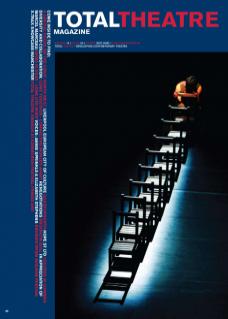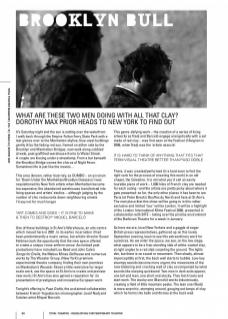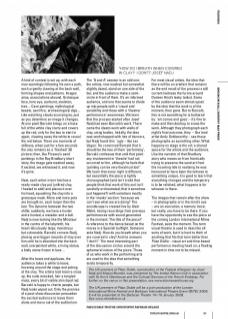It’s Saturday night and the sun is setting over the waterfront. I walk back through the Empire-Fulton Ferry State Park with a last glance over to the Manhattan skyline, blue-steel buildings gently lit by the fading red sun, framed on either side by the Brooklyn and Manhattan Bridges; now walk along cobbled streets, past graffitied warehouse fronts to Water Street. A couple are kissing under a streetlamp. From a bar beneath the Brooklyn Bridge comes the chorus of Night Fever. Sometimes life is just like the movies…
This area (known, rather bizarrely, as DUMBO – an acronym for ‘Down Under the Manhattan/Brooklyn Overpass’) was requisitioned by New York artists when Manhattan became too expensive; the abandoned warehouses transformed into living spaces and artists’ studios – although judging by the number of chic restaurants down neighbouring streets I’d say not for much longer.
One of these buildings is St Ann’s Warehouse, an arts centre which moved here in 2001. In its earlier incarnation it had been predominantly a music venue, but artistic director Susan Feldman took the opportunity that the new space offered to create a unique cross-artform venue. Acclaimed past productions have included Lou Reed and John Cale’s Songs for Drella, the Mabou Mines' Dollhouse and numerous works by The Wooster Group. (New York’s premiere experimental theatre company, finding their own premises on Manhattan’s Wooster Street a little restrictive for larger scale work, use the space at St Ann’s to create and preview new work.) St Ann’s has also gained a reputation for its presentation of prestigious and innovative European work.
Tonight’s offering is Paso Doble, the acclaimed collaboration between French-Yugoslavian choreographer Josef Nadj and Catalan artist Miquel Barceló.
This genre-defying work – the creation of a series of living artworks as Nadj and Barceló engage energetically with a set made of red clay – was first seen at the Festival d’Avignon in 2006, when Nadj was the ‘artiste associé’. There, it was created/performed (it is hard even to find the right verb for the process of enacting this work) in an old chapel, the Celestine. It is not what you’d call an easily tourable piece of work – 1,000 kilos of French clay are needed for each outing –and the artists are pretty picky about where it gets presented: so far, the only other places it has been to are Paris (at Peter Brook’s Bouffes du Nord) and here at St Ann’s. The next place that this show will be going to in this rather exclusive and limited ‘tour’ will be London. It will be a highlight of the London International Mime Festival 2008, presented in collaboration with BITE – taking over the pristine environment of the Barbican Theatre for a week in January.
So here we are, local New Yorkers and a gaggle of eager British press representatives, gathered up on this lovely September evening, keen to see this extraordinary work for ourselves. As we enter the space, we see, on the low stage, what appears to be a free-standing slab of white-coated clay, at right angles to a red slab carpeting the ground. The lights dim, but there is no sound or movement. Then slowly, almost imperceptibly at first, the back wall starts to bubble. Low-key swampy sounds become more urgent, the movements of the now blistering and cracking wall of clay accompanied by what sounds like slurping quicksand. Two men in dark suits appear, one tall and lean, one short and stocky. They fetch tools and start work. The stocky one (Barceló) works industriously, creating a field of little mountain peaks. The lean one (Nadj) is more anarchic, stomping around, gouging out lumps of clay which he forms into balls and throws at the back wall.
A kind of contest is set up, with each man seemingly following his own a path, each urgently clawing at the back wall, forming shapes and patterns. Images arise, associations abound. Grotesque face, lone eye, sunburst, skeleton, tree.... Cave paintings, mythological beasts, sacrifice, archaeological digs.... Like watching clouds scurrying by, just as you determine an image it changes. At one point Barceló brings on a hose full of the white clay slurry and covers up the red, only for the two to start in again, clawing away the white to reveal the red below. There are moments of stillness, when just for a few seconds the clay remains as a ‘finished’ 3D picture; then, like Picasso’s sand paintings in the Ray Bradbury short story, the image gets washed away, It existed, we witnessed it, and now it’s gone.
Next, each artist in turn fetches a ready-made clay pot (unfired clay, I hasted to add) and places it over his head, squashing the clay into a grotesque mask. More and more pots are brought on, each larger than the last. The dynamic between the two shifts: suddenly, we have a hunter and a hunted, a matador and a bull. Nadj is now looking like the Minotaur in the centre of the labyrinth, his head ridiculously large; monstrous but vulnerable. Barceló corners Nadj, placing ever bigger mounds of clay over him until he is absorbed into the back wall, overpainted white, a living statue, a body stone-frozen in lava…
After the bows and applause, the audience takes a while to leave, hovering around the stage and poking at the clay. The artists look bizarre close up, the suits wrecked, hair a tangled mess, every bit of visible skin dyed red. Barceló is happy to chat to people, but Nadj looks wiped out. Only the promise of a post-show discussion persuades the excited audience to leave them alone and move out of the auditorium.
The ‘Q and A’ session is an odd one: the artists, now washed but somewhat slightly dazed, stand on one side of the bar, and the audience make a semicircle in front of them. It’s an informed audience, and one that seems to divide up into people with a ‘visual arts’ sensibility and those with a ‘theatre/ performance’ awareness. We learn that the process started after Josef Nadj had seen Barceló’s work. There came the ideato work with walls of clay, using bodies. Initially, the idea was workshopped with lots of dancers, but Nadj found this ‘ugly – like Las Vegas’. He convinced Barceló that it should be the two of them ‘performing’, Barceló confesses that until that point any involvement in ‘theatre’ had not occurred to him, although he feels that ‘painting can be very theatrical too!’ We learn that every night is different, but essentially the piece is tightly choreographed (and isn’t it odd that people think that work of this sort isn’t carefully orchestrated; that it somehow just happens?) with variations mostly in the ‘masks’ section: ‘because we can’t see what we are doing!’ The soundscape is created live by Alain Mahé, mixing recordings from previous performances with sound generated in the moment. The title of the piece? A reference to the dance based on the moves in a Spanish bullfight. Someone asks Nadj: How do you breath when you are covered in clay? And he answers ‘I don’t!’. The most interesting part of the discussion circles around the ephemeral nature of the piece. Those of us who work in the performing arts are used to the idea that something exists temporarily.
For most visual artists, the idea that there will be an artefact that remains as the end result of the process is still current (witness the furore around Damien Hirst’s leaky tanks). Some of the audience seem almost upset by the idea that the work is of the moment, then gone. But to Barceló, this is not something he is bothered by: ‘art comes and goes’ – it’s fine to make and then destroy, to erase the work. Although they photograph each night’s final outcome, they – like land artist Andy Goldsworthy – see these photographs as something other. What happens on stage is the art; a shared space for the artists and the audience. Like the narrator of that Bradbury story who moves on from frantically trying to preserve the sand art from the incoming tide to realising he was honoured to have been the witness to something unique, it is good to learn that everything changes and the temporary is to be relished; what happens is for whoever is there.
The images that remain after the show – in photographs or in the mind’s eye – are an evocation, a memory trace; but really, you have to be there. If you have the opportunity to see the piece at the coming London International Mime Festival, seize the moment. The term visual theatre is used to describe all sorts of work, but it is hard to think of anything that fits that term better than Paso Doble – visual art and time-based performance meeting head on; a fleeting moment in time not to be missed.
The US premiere of Paso Doble, a production of the Festival d’Avignon by Josef Nadj and Miquel Barceló, was presented by The Institut Ramon Llull in association with St Ann’s Warehouse and the Cultural Services of the French Embassy. For further on the venue or this presentation, see www.stannswarehouse.org
The UK premiere of Paso Doble will be a joint production of the London International Mime Festival and Barbican International Theatre Event (BITE) 2008. It will be presented at the Barbican Theatre 16–18 January 2008. See www.mimefest.co.uk


